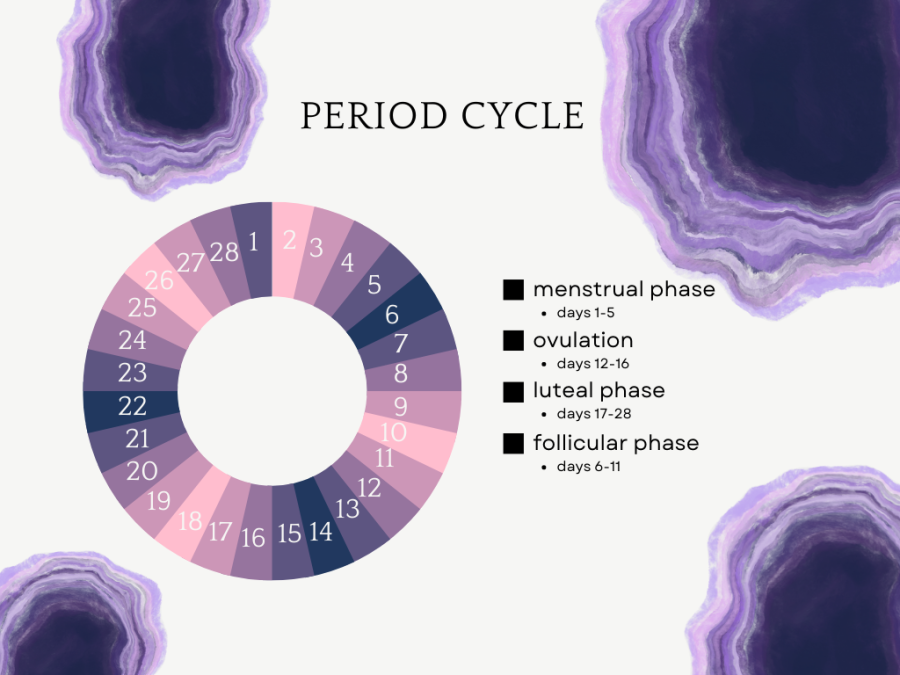Get To Know Your Flow
January 31, 2023
Disclaimer: for this story I am going to use the words: “male” and “female”. I understand that there are people who do not identify with these terms that have a menstrual cycle, but for the sake of space and cohesiveness, I will be using female and male terminology.
The standard workday is a single day, constructed by a male. Although this day works well for males, it doesn’t work so well for females. Every single female bodied individual on Earth has a different, 21-35 day cycle (average is about 28 days). Every male runs on a 24 hour cycle. A female’s cycle contains 2 phases broken into 4 different stages: menstrual, follicular, ovulation (phase 1) and luteal phase. Each phase is completely different from the other, each day will not look the same. For a male bodied individual, their hormones cycle through on a 24 hour schedule where testosterone levels are highest in the morning and lowest at night. Because a male’s cycle resets each day, the standard workday works well for them. Because a female doesn’t run on this 24 hour cycle, their workdays are much harder.
Female Cycle:
- 2 phases and 4 stages. The 2 phases are the follicular and luteal phase lasting 21-35 days (average 28 days). In phase one, you have your follicular phase, ovulation stage, and menstruation stage. While the luteal phase has 1 part. And after that the whole thing starts over again.
- Menstrual: aka your period, progesterone and estrogen levels drop causing mood swings, cramps, back pain, tiredness, headaches, breakouts, and much more. Each female has a different length of period, on average ranging from 5-7 days, days 1-6 roughly. Each flow is different too. Some may be very heavy, others may be very light. Some people may have to stay in bed due to horrible cramps or other pms symptoms, some may be fine to continue daily life.
- Follicular: this phase is when the egg is housed in the ovaries ready to be fertilized or released through menstruation. This phase lasts from days 7-13 (roughly) and females feel better during this phase. They experience increased energy, relatively better skin, and happier moods, due to higher estrogen levels.
- Ovulation: this part of your cycle is when your ovaries release an unfertilized egg. It lasts from days 14-18 (about) and females may experience: heightened senses, soreness, pelvic or abdominal pain, nausea and headaches and a slightly elevated temperature. This stage leads into the period.
- Luteal: this part of your cycle is in phase 2 which begins roughly around day 18 and lasts until you get your period (about 10ish days). The lining of the uterus begins to thicken and females might experience: bloating, mood changes, headaches, weight gain, food cravings, and trouble sleeping.
Male Cycle:
- 1 phase that resets every 24 hours
- They have about 10x the testosterone than female bodied individuals
- They feel most productive in the morning and decrease throughout the day.
- They can experience mood swings and other symptoms if their hormone levels drop, but that is normally due to outside factors rather than “a cycle”
- While yes, men experience mood changes, it is not dependent on their cycle, but the level of hormones (low testosterone and high-stress cortisol levels). Men don’t experience period cramps or bleeding. Because their cycle is the same they normally feel pretty consistent day to day (I know men too have emotions that differ but I am talking strictly for the purpose of comparing cycles) and normally can keep the same schedule.
Differences:
- While yes, both men and females can experience mood swings and headaches, men cannot experience period cramps or bleeding. This alone causes females great discomfort and shifts how productive they are. Many times, females will have less energy, making it harder for them to work out, stay focused, and get through the day.
- I am not saying the world needs to change to fit the cycle of females. All I am pointing out is how a female’s cycle does affect them, and sometimes they need a females bit of grace. It is hard going to work, school, or practice on your period. Many females will bleed through their clothes, become more easily upset, or just flat out tired.
Solution:
- Some simple solutions I would offer for workplaces and schools would be:
- Allow females to take time needed during the day without question to care for themselves.
- Allowing students to leave the classroom without question or pressure
- Having period products free and accessible in schools (especially the bathroom)



